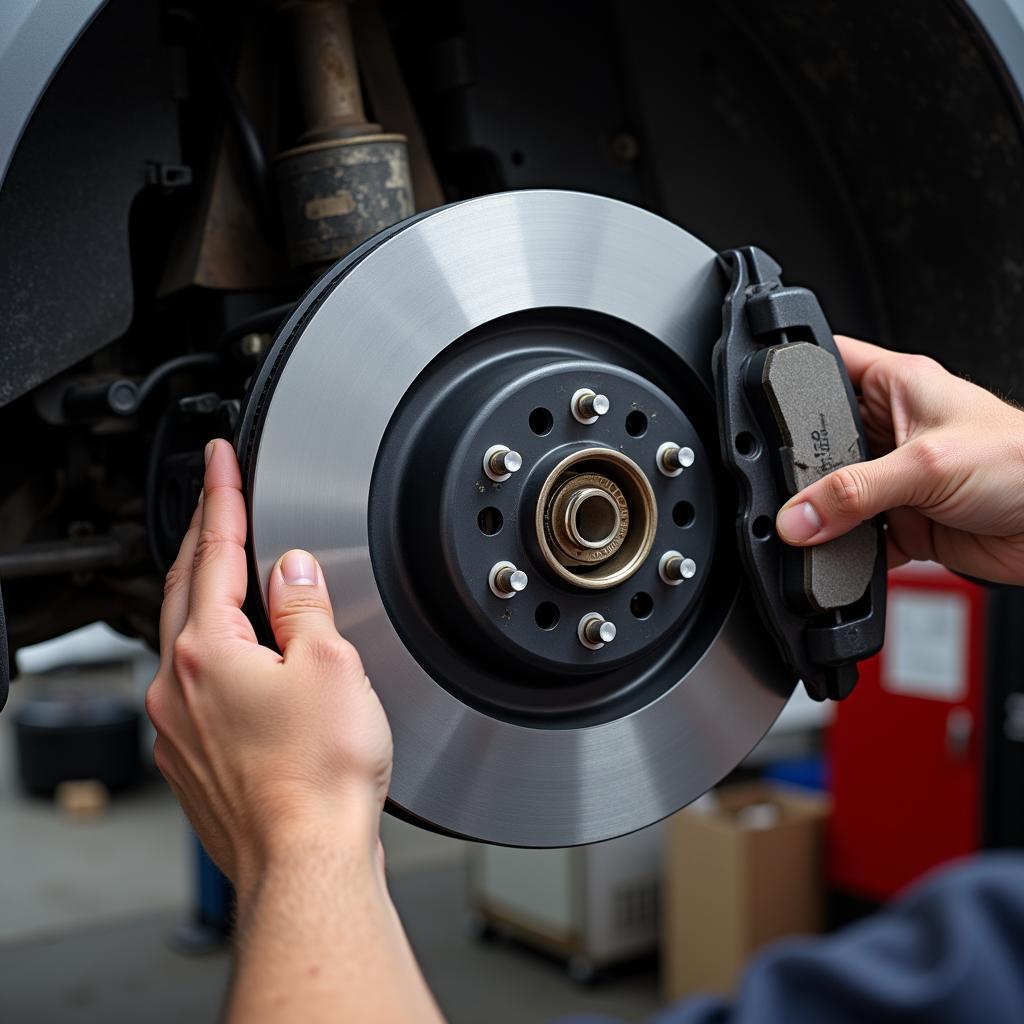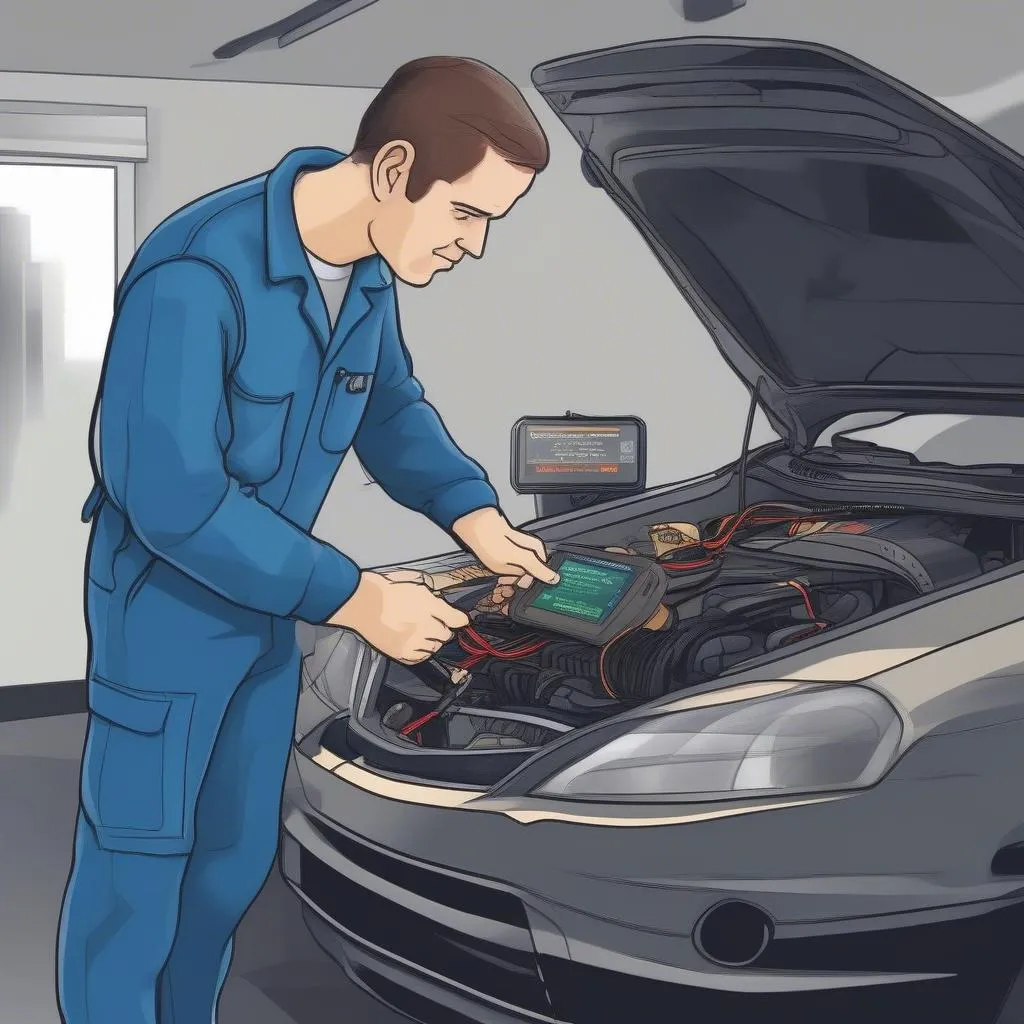The brake pad warning light on your Audi A6 is a crucial safety feature that you should never ignore. This light illuminates to alert you that your brake pads have worn down to a point where they need to be replaced. Ignoring this warning can lead to costly repairs and, more importantly, compromise your safety on the road.
Understanding Your Audi A6 Brake Pad Warning Light
Your Audi A6 utilizes sensors within the brake system to monitor the thickness of the brake pads. When the pads wear down to a predetermined level, these sensors trigger the brake pad warning light on your dashboard. This light typically appears as a circle with dashed lines surrounding it and may be accompanied by the word “BRAKE.”
Common Causes of the Brake Pads Warning Light
While worn brake pads are the most common culprit behind the warning light, several other factors can trigger it:
- Worn brake pad sensors: The sensors themselves can become damaged or worn out over time, leading to a false warning light.
- Damaged brake caliper: A malfunctioning brake caliper can cause uneven pad wear, triggering the sensor prematurely.
- Low brake fluid: While a separate warning light usually indicates low brake fluid, it can also trigger the brake pad warning light in some cases.
- Electrical issues: A short circuit or wiring problem in the brake pad sensor system can cause the light to illuminate.
What to Do When Your Brake Pad Warning Light Comes On
If your Audi A6’s brake pad warning light comes on, follow these steps:
- Safely pull over: Find a safe location to stop your vehicle as soon as possible.
- Check your brake fluid: Ensure the brake fluid reservoir is full. If it’s low, add the appropriate brake fluid.
- Inspect your brake pads: If possible, visually inspect your brake pads for wear. Look for thin pads or metal-on-metal contact.
 Inspecting Audi A6 Brake Pads
Inspecting Audi A6 Brake Pads
Can I Still Drive with the Brake Pad Warning Light On?
Driving with the brake pad warning light on is highly discouraged. Continuing to drive with worn brake pads will reduce your braking efficiency and could lead to rotor damage, significantly increasing repair costs. In extreme cases, complete brake failure can occur, posing a serious safety risk.
Diagnosing and Fixing the Issue
While worn brake pads are the most common cause, it’s essential to diagnose the root of the problem correctly.
DIY Inspection
If you are comfortable with basic car maintenance, you can inspect the brake pads yourself. However, for accurate diagnosis and repair, taking your Audi A6 to a qualified mechanic specializing in Audi vehicles is recommended.
Professional Diagnosis
A professional mechanic will have the expertise and tools to:
- Inspect the brake pads and rotors: They will accurately measure the remaining pad thickness and check the rotors for damage.
- Test the brake pad sensors: Using diagnostic equipment, they can verify the sensors are functioning correctly.
- Inspect the brake system: They will thoroughly examine the entire brake system, including calipers, hoses, and lines, for any signs of wear or damage.
Brake Pad Replacement: What to Expect
If your brake pads require replacement, a mechanic will:
- Remove the old brake pads: They will safely remove the worn brake pads from the calipers.
- Inspect and resurface the rotors: The brake rotors will be inspected for damage and resurfaced or replaced if necessary.
- Install new brake pads: New brake pads will be installed, ensuring they are compatible with your Audi A6 model.
- Test the brakes: After installation, the mechanic will test the brakes to ensure they are functioning correctly.
Preventing Future Brake Pad Warning Light Issues
- Regular brake inspections: It’s recommended to have your brakes inspected at least once a year or every 10,000-12,000 miles.
- Avoid aggressive driving: Harsh braking and rapid acceleration can significantly accelerate brake pad wear.
- Quality brake pads: Using high-quality brake pads designed for your Audi A6 model can extend the life of your brakes.
By understanding the importance of your Audi A6’s brake pad warning light and taking the necessary steps to address the issue, you can ensure your safety and avoid potentially costly repairs. Remember, preventative maintenance and timely repairs are key to keeping your vehicle running smoothly and safely.
Frequently Asked Questions
Can I replace my Audi A6 brake pads myself?
While it’s technically possible, replacing brake pads is a critical safety component best left to qualified mechanics, especially if you’re not familiar with car repair.
How long do Audi A6 brake pads last?
Brake pad lifespan varies depending on driving style, road conditions, and brake pad quality. Typically, Audi A6 brake pads last between 30,000 to 70,000 miles.
How much does it cost to replace brake pads on an Audi A6?
The cost of brake pad replacement can vary based on location, labor rates, and the type of brake pads used. On average, expect to pay between $300 to $500.
Can I drive my Audi A6 if the brake pad warning light is flashing?
A flashing brake pad warning light usually indicates a more serious issue within the brake system. It’s crucial to stop driving immediately and have your vehicle towed to a mechanic for inspection.
What is the difference between the brake pad warning light and the brake system warning light?
The brake pad warning light specifically indicates worn brake pads, while the brake system warning light could indicate a broader range of issues, including low brake fluid or a problem with the ABS system.
Need help with a Mondeo brake pad warning light? Check out our guide for more information.
Experiencing issues with your 2016 Audi Q5 brake pad warning light? Our article provides insights and solutions.

